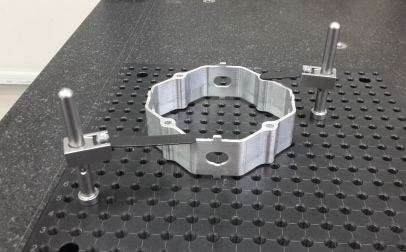Coordinate Measuring Machines (CMMs) are the most developed 3-D metrology system, recording precisely the shape and dimensions of a mechanical object.
They accomplish precision measurements (<2 µm) and are best suited for most modern industrial applications, the production of fine structures, high precision components and assembled mechanical structures.
In addition to the high dimensional accuracy, the use of CMM minimizes human error in the prosecution and reading the measurements, as opposed to conventional measuring instruments.
Furthermore, today's CMMs allow the import and export of digital CAD models and the ability to identify the physical object with its digital modeling, capable of working through a user-friendly interface where the quality control manager uses a variety of prepared measurement routines (hole measurement routine, level, etc.) thus simplifying the control process.
Therefore, this method no longer allows the user to manually control the measuring machine as it is controlled through the software environment, which also provides a collision-avoidance system.
Despite the convenience provided by modern Coordinate Measuring Machines (CMMs), there are some basic rules that must be followed for the correct measurement of the mechanical object to be tested, which are:
Rule 1: Calibration
Correct calibration of the spike attached to the head, each time a different spike must be used to determine the shape and offset of the spike. Calibration is usually performed by contacting the spike with a sphere or cube of verified dimensions.
Rule 2: Coordinate system
Correct selection and definition of a measurement coordinate system based on the characteristics of the object. For each point of contact of the spike (of the sensor) with the object, the X, Y, Z are recorded as to the local reference system selected. Therefore, incorrect selection of local reference system can lead to incorrect measurements.
Rule 3: Clamping Systems
Correct support for the object selected for measurement. It is recommended to use special plates, which "tighten" the object to the plate by adjusting it as the user wishes, giving flexibility in measurement.
Rule 4: Measurement Points
Definition of the number of points required to define basic geometric elements. The impacted software interprets and guides measurements by creating geometric features that require more than one point (e.g. defining a straight line requires at least 2 points, a plane or circle 3, a sphere 4, etc.)
Rule 5: Use of automated routines
Correct selection and use of available automated routines that have special software for recording object geometries, so that the human factor does not affect measurements.
Rule 6: Environmental working conditions
Maintaining and periodically checking the conditions of the measurement space is very important for the industrial applications industry and for achieving the precision required. The most important environmental parameter that can reduce the accuracy of measurements is temperature. The ideal temperature is usually set at 20 ° C and the permissible range of 18 ° C to 22 ° C.



Comments powered by CComment